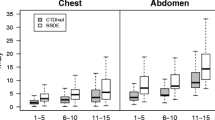Abstract
Radiation dose associated with CT is an important safety concern in patient care, especially in children. Technical advancements in multidetector-row CT scanner technology offer several advantages for clinical applications; these advancements have considerably increased CT utilization and enhanced the complexity of CT scanning protocols. Furthermore there are several scan manufacturers spearheading these technical advancements, leading to different commercial names causing confusion among the users, especially at imaging sites with scanners from different vendors. Several scientific studies and the National Council on Radiation Protection and Measurements (NCRP) have shown variation in CT radiation doses for same body region and similar scanning protocols. Therefore there is a need for standardization of scanning protocols and nomenclature of scan parameters. The following material reviews the status and challenges in standardization of CT scanning and nomenclature.
Similar content being viewed by others
References
(2012) IMV 2012 CT Market Outlook Report. http://www.imvinfo.com/index.asp?sec=mkt& sub=omkt& pag=def& pid=87309. Accessed 26 April 2012
Bhargavan-Chatfield M, Morin RL (2013) The ACR Computed tomography dose index registry: the 5 million examination update. J Am Coll Radiol 10:980–983
McCollough CH (2013) Standardization versus individualization: how each contributes to managing dose in computed tomography. Health Phys 105:445–453
Pandian V, Miller CR, Schiavi AJ et al (2014) Utilization of a standardized tracheostomy capping and decannulation protocol to improve patient safety. Laryngoscope. doi:10.1002/lary.24625. [Epub ahead of print]
Lee S, Stachler RJ, Ferguson BJ (2014) Defining quality metrics and improving safety and outcome in allergy care. Int Forum Allergy Rhinol 4:284–291
Haylen B (2013) IUGA-ICS terminology and standardization documents: maximal use offers maximum patient and academic benefit. Int Urogynecol J 24:361–362
Schauer DA (2009) NCRP report 160: ionizing radiation exposure of the population of the United States. National Council on Radiation Protection and Measurement. Bethesda, MD
Calvert C, Strauss KJ, Mooney DP (2012) Variation in computed tomography radiation dose in community hospitals. J Pediatr Surg 47:1167–1169
Koller CJ, Eatough JP, Bettridge A (2003) Variations in radiation dose between the same model of multislice CT scanner at different hospitals. Br J Radiol 76:798–802
Kalra MK, Saini S (2006) Standardized nomenclature and description of CT scanning techniques. Radiology 241:657–660
American Association of Physicists in Medicine (2012) CT Lexicon, ver. 1.3. http://www.aapm.org/pubs/CTProtocols/documents/CTTerminologyLexicon.pdf. Accessed 4 June 2014
Radiological Society of North America (2014) RadLex® Web site. http://www.rsna.org/radlex/. Accessed 19 Feb 2014
Gruber TR (1993) A translation approach to portable ontology specifications. Knowl Acquis 5:199–220
American Association of Physicists in Medicine (2014) CT scan protocols. http://www.aapm.org/pubs/CTProtocols/. Accessed 19 Feb 2014
Singh S, Kalra MK, Hsieh J et al (2010) Abdominal CT: comparison of adaptive statistical iterative and filtered back projection reconstruction techniques. Radiology 257:373–383
Singh S, Kalra MK, Gilman MD et al (2011) Adaptive statistical iterative reconstruction technique for radiation dose reduction in chest CT: a pilot study. Radiology 259:565–573
Singh S, Kalra MK, Do S et al (2012) Comparison of hybrid and pure iterative reconstruction techniques with conventional filtered back projection: dose reduction potential in the abdomen. J Comput Assist Tomogr 36:347–353
Kalra MK, Woisetschläger M, Dahlström N et al (2012) Radiation dose reduction with sinogram affirmed iterative reconstruction technique for abdominal computed tomography. J Comput Assist Tomogr 36:339–346
Pontana F, Pagniez J, Flohr T et al (2011) Chest computed tomography using iterative reconstruction vs. filtered back projection (part 1): evaluation of image noise reduction in 32 patients. Eur Radiol 21:627–635
Yoo RE, Park EA, Lee W et al (2013) Image quality of adaptive iterative dose reduction 3D of coronary CT angiography of 640-slice CT: comparison with filtered back-projection. Int J Cardiovasc Imaging 29:669–676
Kofler JM Jr, Jordan DW, Orton CG (2014) Point/counterpoint. exposure tracking for x-ray imaging is a bad idea. Med Phys 41:010601
Conflicts of interest
Drs. Singh and Kalra have no financial interests, investigational or off-label uses to disclose.
Author information
Authors and Affiliations
Corresponding author
Rights and permissions
About this article
Cite this article
Singh, S., Kalra, M.K. Standardized CT protocols and nomenclature: better, but not yet there. Pediatr Radiol 44 (Suppl 3), 440–443 (2014). https://doi.org/10.1007/s00247-014-3096-8
Received:
Revised:
Accepted:
Published:
Issue Date:
DOI: https://doi.org/10.1007/s00247-014-3096-8




